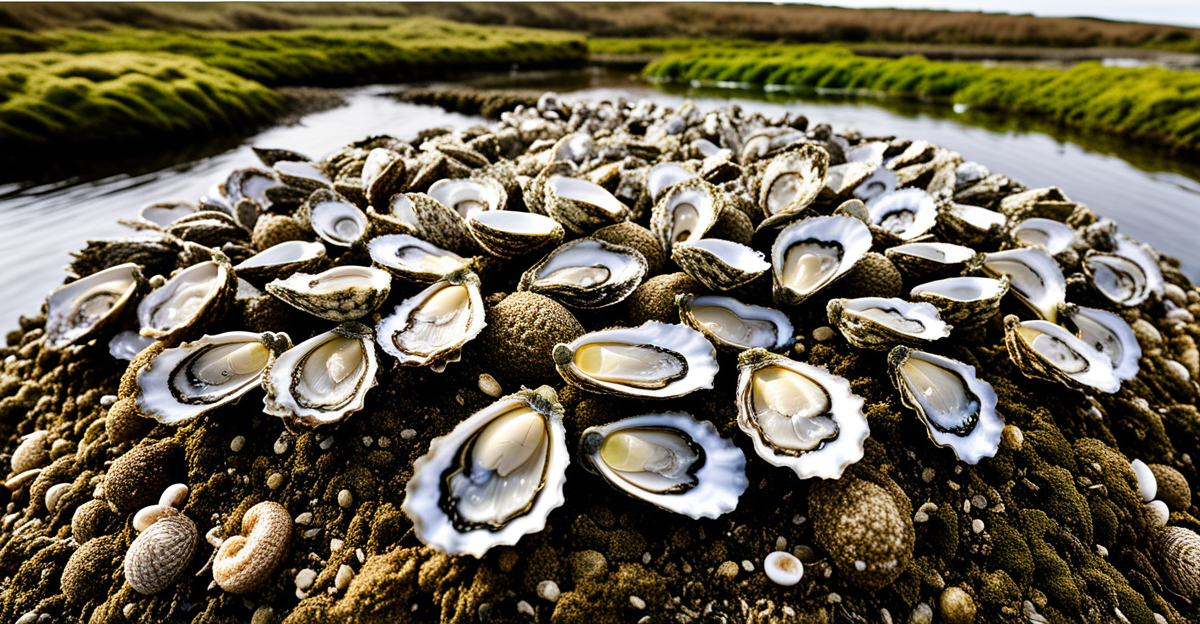Importance of Restoring Oyster Habitats
Oyster habitats play a crucial role in maintaining the ecological balance of marine ecosystems. These habitats provide numerous benefits, both environmentally and economically, making their restoration a matter of global interest.
Role and Ecological Significance
Oyster reefs serve as vital structures in marine ecosystems. They act as natural water filters, significantly enhancing water quality by removing algae and pollutants. Moreover, their complex structures offer habitat to a variety of marine life, promoting biodiversity. These reefs also contribute to protective coastal barriers, mitigating the impact of erosion and storm surges.
Economic and Social Benefits
Healthy oyster populations help stimulate local economies through fishing, tourism, and related industries. Oyster restoration projects often involve various local and national stakeholders, creating jobs and fostering community involvement. Communities benefit not just economically, but also socially, as these initiatives bring residents together, encouraging engagement and environmental stewardship.
The restoration of oyster habitats is thus a multidimensional effort that supports ecological health, economical growth, and community well-being.
This might interest you : Enhancing wild animal protection: discover how new uk hunting regulations shield foxes and hares
Innovative Approaches to Habitat Restoration
In the pursuit of effective oyster habitat restoration, innovative methods have emerged, offering promising solutions to enhance marine ecosystem health. These techniques are not only vital for reviving oyster populations but also for ensuring the sustained ecological balance of our coastlines.
Techniques for Restoration
Technological advancements play a pivotal role in revolutionizing restoration efforts. Innovative methods such as 3D reef printing and submerged structures are being employed to mimic natural oyster reefs. These structures provide essential surfaces for oyster spat to settle and thrive. One such successful implementation is observed in UK coastal areas, where these techniques have facilitated significant ecological recovery.
Community and Stakeholder Involvement
Local communities are integral to the success of restoration projects. Collaborations with stakeholders, including NGOs and conservation groups, are crucial for fostering sustainable initiatives. Community-led initiatives have demonstrated the power of collective action, as seen in projects where residents actively participate in monitoring and maintaining restored areas.
Policy and Funding Mechanisms
Supportive policies and robust funding mechanisms are essential for advancing restoration work. Governments provide grants and incentives, encouraging both private sectors and communities to partake in these efforts. The synergy between policy frameworks and financial support ensures that restoration projects are not only initiated but also sustained over time, highlighting the need for continued investment in ecological engineering of oyster habitats.
Scientific Research and Findings
Scientific research into oyster habitat restoration has become a cornerstone for understanding and enhancing marine ecosystem health. Recent studies have underscored the critical ecological roles oysters play, such as promoting water filtration and biodiversity, while providing concrete data on how their habitats impact broader marine environments.
Recent Scientific Studies
Emerging research has illuminated the significant potential of oyster reefs to act as natural defenses against coastal erosion and storm surges, fortifying communities against the adverse effects of climate change. By filtering excess nutrients and pollutants, oysters help maintain clearer and healthier waters, thus directly benefiting marine life dependent on such ecosystems. Additionally, progress has been made in quantifying how restored oyster habitats contribute to biodiversity by creating habitats for a variety of marine organisms.
Key Ecological Findings
A pivotal revelation from recent studies is the identification of optimal restoration techniques that enhance oyster populations’ resilience against environmental stressors. Findings indicate that oyster habitat restoration projects incorporating technological innovations, like artificial reef structures, demonstrate enhanced recovery rates. Specifically, UK coastal areas have shown marked success by integrating these advanced methods, leading to quicker ecological recovery and sustained oyster productivity.
Importance of Ongoing Research
Continued research and monitoring remain vital to the success of restoration efforts. By regularly assessing restored sites, scientists can adapt techniques to address emerging challenges, such as changing water salinity and temperature fluctuations. Establishing long-term ecological study programs enables stakeholders to stay proactive, implementing strategies that ensure the longevity and health of oyster populations. Real-time data collection offers invaluable insights, driving informed decisions for ecological engineering and conservation policies.
Success Stories in Oyster Recovery
The restoration of oyster habitats around the globe has seen varied degrees of success, with numerous projects leaving a lasting, positive impact on marine environments and local communities. These success stories highlight the restoration success of oyster habitats, drawing attention to effective strategies and best practices that can be applied elsewhere.
Case Study: Notable Restoration Projects
One exemplary restoration success story comes from the UK, where innovative techniques have been coupled with community collaboration to revitalize oyster populations. Projects like these emphasize the significance of tailored approaches, integrating state-of-the-art technologies such as artificial reefs and community-led monitoring programs. Essential factors for their success have included engaging local stakeholders and fostering widespread community support, ensuring sustainability and resilience.
The transferability of these strategies forms the core of their best practices. Other regions can adapt these methods, incorporating local knowledge and conditions to achieve similar ecological and economic benefits. A key advantage has been the shared ownership of projects, where community members are directly involved in project implementation and monitoring, reinforcing a collective commitment to long-term restoration goals.
Long-term Impact Assessment
Evaluating the long-term impact of oyster habitat restoration is crucial for understanding the broader implications of these initiatives. The ecological recovery observed in successfully restored areas often translates into a resurgence of local biodiversity, with oyster reefs providing habitats for various marine organisms.
Economically, these restorations have rejuvenated local fisheries and boosted tourism, directly benefiting local communities. However, achieving sustained success requires overcoming challenges such as environmental stressors and climate change impacts. Establishing ongoing management strategies and conducting regular monitoring are essential to maintaining the long-term health and viability of oyster populations. An adaptive management approach ensures that these ecosystems remain robust against future challenges while continuing to support local economies and preserve biological diversity.
Challenges in Restoring Oyster Habitats
Restoring oyster habitats is fraught with challenges that require strategic solutions to ensure their resilience and sustainability. The obstacles vary, but the most significant threats stem from environmental stressors, including climate change and pollution, which have profound impacts on oyster populations.
Environmental Stressors and Their Impact
Climate change, with its rising sea temperatures and increasing ocean acidity, presents a formidable challenge to oyster restoration. These conditions stress oysters, reducing their survival rates and impacting their role in marine ecosystem health. Moreover, pollution, particularly from agricultural runoff, introduces excessive nutrients and toxins into the water. This can lead to harmful algal blooms, suffocating oyster reefs and disrupting their ability to filter water and create habitats.
Mitigation Strategies
To combat these challenges, innovative restoration methods are essential. Implementing techniques such as using more resilient oyster strains and enhancing water quality through upstream pollution control can bolster oyster populations. Additionally, adaptive management strategies, which involve continuous monitoring and flexible approaches to restoration, are crucial for responding to the ever-changing environmental conditions.
Collaborative efforts between scientists, local communities, and policymakers are pivotal. By aligning restoration goals with broader environmental policies, these partnerships can develop targeted interventions that mitigate threats and enhance the ecological engineering of oyster reefs. This integrated approach ensures that restoration initiatives are not only effective but also sustainable against future adversities.









